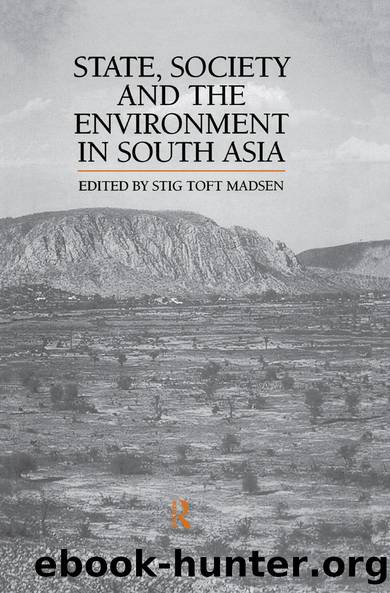State, Society and the Environment in South Asia by Stig Toft Madsen

Author:Stig Toft Madsen [Madsen, Stig Toft]
Language: eng
Format: epub
ISBN: 9781138982925
Google: __4PvgAACAAJ
Publisher: Routledge
Published: 2016-01-31T04:55:58+00:00
Structural Asymmetries between the Rural Rich and Poor
The size distribution of income has an impact on patterns of natural resource use because differences in income are related to differences in economic opportunities among households. These differences can be identified with respect to a wide range of social, economic and political criteria. As they concern unequal opportunities for action, they are termed structural asymmetries. The causes of structural asymmetries are complex: while some can be traced directly to income inequality, others have to be viewed together with income inequality as joint effects of a common cause.
Agrarian society in India displays a wide spectrum of both incomes and economic opportunities across households and individuals. Economic opportunities may differ even among households with identical incomes. For the extreme ends of the income distribution, however, there is a set of socioeconomic characteristics which is related unambiguously to income.
In order to identify linkages between income distribution and environmental degradation on a general level, the following analysis concentrates on the two extreme ends of the rural income distribution. Households at the lower end are termed âpoorâ: they comprise all households whose income is below the Indian poverty line for rural areas (i.e. Rs 49.09 per capita per month at 1973â74 prices).3 The households at the upper end are termed ârichâ. In principle, they could be identified empirically by a âwealth lineâ defined in analogy to the poverty line. Viewed from an institutional perspective, it is the big landowners (> 4 ha), moneylenders and large traders who constitute this group. Absentee landlords who reside in the cities are considered members of the rural rich.
There is always a problem in broad generalizations about the poor. It has been warned that these generalizations reflect rather the prejudices of researchers and development agencies than the true situation of the poor (Chambers, et al. 1989; Chambers 1994). In the analysis that follows in the next section, these generalizations will be used as abstractions which enable us to analytically describe some mechanisms of environmental degradation considered typical for India.
Table 7.1 contains a typology of the relevant structural asymmetries between the rich and the poor. The criteria of comparison have been grouped into four classes which comprise resource endowments, positions in markets, political economy variables and derived variables.
As far as resource endowments are concerned, it is well known that poor households are endowed with less land, natural resources and capital than the rich (Chambers, et al. 1989). Furthermore, the productivity of their assets is lower at a given level of labour input: the poor own less productive soils and capital. Closely related to this is the fact that the resources owned by the poor are more vulnerable to ecological degradation. The poor settle and practise agriculture on steep slopes that are prone to erosion, or they live in low-lying areas close to rivers which are subject to floods. In times of drought, their wells dry up earlier than those of the rich.
Table 7.1 Structural asymmetries between rural rich and poor
Download
This site does not store any files on its server. We only index and link to content provided by other sites. Please contact the content providers to delete copyright contents if any and email us, we'll remove relevant links or contents immediately.
International Integration of the Brazilian Economy by Elias C. Grivoyannis(74782)
The Radium Girls by Kate Moore(11621)
Turbulence by E. J. Noyes(7700)
Nudge - Improving Decisions about Health, Wealth, and Happiness by Thaler Sunstein(7242)
The Black Swan by Nassim Nicholas Taleb(6764)
Rich Dad Poor Dad by Robert T. Kiyosaki(6175)
Pioneering Portfolio Management by David F. Swensen(6079)
Man-made Catastrophes and Risk Information Concealment by Dmitry Chernov & Didier Sornette(5647)
Zero to One by Peter Thiel(5488)
Secrecy World by Jake Bernstein(4388)
Millionaire: The Philanderer, Gambler, and Duelist Who Invented Modern Finance by Janet Gleeson(4094)
The Age of Surveillance Capitalism by Shoshana Zuboff(3983)
Skin in the Game by Nassim Nicholas Taleb(3965)
The Money Culture by Michael Lewis(3846)
Bullshit Jobs by David Graeber(3830)
Skin in the Game: Hidden Asymmetries in Daily Life by Nassim Nicholas Taleb(3723)
The Dhandho Investor by Mohnish Pabrai(3560)
The Wisdom of Finance by Mihir Desai(3523)
Blockchain Basics by Daniel Drescher(3329)
